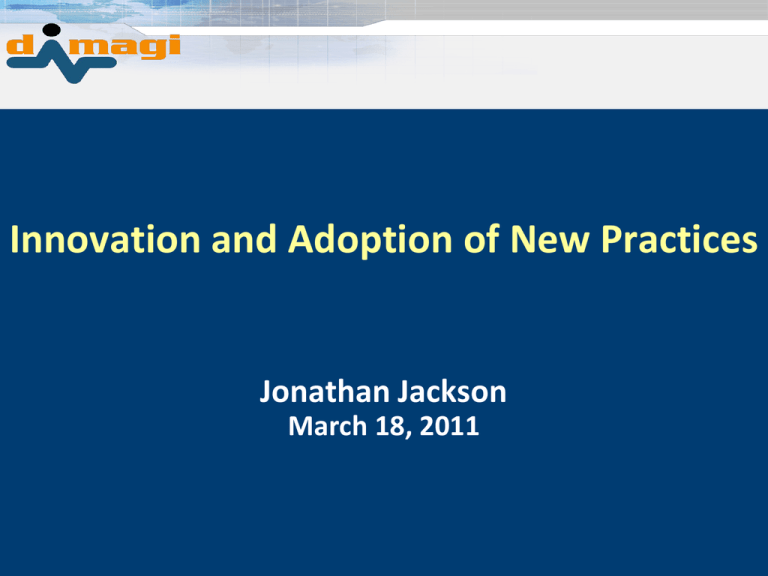
Innovation and Adoption of New Practices
Jonathan Jackson
March 18, 2011
Contents
The Need for Innovation
Factors for Adoption of Innovation
Challenges for High-Value Adoption of Innovation
1
The Need for Innovation
2
Childhood (<5) Mortality (per 1000)
Health outcomes per GDP vary widely
300
250
Rwanda
R2 = 0.58
200
Cambodia
150
100
Kenya
50
0
100
Vietnam
1000
10000
100000
GDP PPP per capita (2005)
© World Health Organization (WHO). All rights reserved. This content is excluded from
our Creative Commons license. For more information, see http://ocw.mit.edu/fairuse.
Source: WHO
3
Health spend per GDP is fixed
Log Health Expenditures/capita
9
United States
8
15.4
$17,069
9.8
$6,617
6.2
$1,486
4.7
$618
5.0
$134
5.3
Portugal
7
R2 = 0.95
6
Poland
5
China
4
India
3
2
1
$39,841
Ethiopia
4
5
6
7
8
9
10
11
12
Log GDP/capita , 2004
© World Health Organization (WHO). All rights reserved. This content is excluded from
our Creative Commons license. For more information, see http://ocw.mit.edu/fairuse.
GDP per
capita
Health exp,
as % GDP
Source: WHO/NHA, Brookings Inst.
4
Low Resource Technology Landscape
The International Health IT field has had rapid progress in the last 10 years
Becoming core research labs in several universities (TIER group at Berkley, MIT,
Computer Science Labs in TZ, UG, Kenya, Ghana)
Many new non-profit and for-profit entities
Mostly still donor funded, though more consumer focus is coming as well
Mostly still in pilot phases, small number of successful projects going to scale
The most innovative technology does not dictate who “wins”
5
Potential for Innovation in Technology
Use of mobile (and tablet), low cost computing
Measuring value instead of Indicators
National (connected) IT platforms: designed for interoperability
National Strategy before entrenched Industry
Integrated Supply Chain / Logistics / HR
Most (Information) Technology has passed services ability to support it
But, Also a good chance to repeat the same mistakes over!
6
Factors for Adoption of Innovation
7
Perception of Innovation (From Rogers)
Relative Advantage
Compatibility
Complexity
Trialability
Observability
Longevity (Future Proof?)
Diffusion of preventive innovations, Rogers, 1995
8
Characteristics of people who adopt innovation
Image of crossing the quality chasm in the technology adoption lifecycle has been removed due to copyright restrictions.
Crossing the Chasm, Geoffrey Moore, 1991
9
Contextual Factors
Type
Decision Made By
Optional Innovation-Decision
individual who is in some way
distinguished from others in a social
system.
Collective Innovation-Decision
all individuals of a social system.
Authority Innovation-Decision
Few individuals in positions of
influence or power for the entire
social system by
Diffusion of preventive innovations, Rogers, 1995
10
Challenges for High-Value Adoption of
Innovation
11
Ecosystem
ICT Development projects shares characteristics of traditional startups
– Management team
– Market
– Customer
– Competitors
– Evidence Base
– Barriers to entry
– Plan
– Inflection Points
– Exit
Development sector is just as competitive as the private sector
– Multi-billion dollar industry
– Many players
– Much gamesmanship / positioning / marketing
Often the “Innovation” is the easy part
12
Utilizing Innovation often means Implementing Change Management
Roles and responsibilities will change throughout the organization
Cultural norms and communications will need to adapt
Attitude of continuous improvement needs to be adopted
Push back from people who are scared and/or don’t understand
People don’t understand how to get to where they want to go or they would
be there already
13
Agile Deployment
“Waterfall” deployment doesn’t work any better in deploying technologies
that “Waterfall” software development does in creating them
Need to adapt innovation to the changing ecosystem on the ground
Plan for changing requirements, features, and attitudes through the course
of scaling up
Plan for new competitors and partners to enter during the scale-up phase
Image courtesy of Hamed Saber from Flickr.
14
Difficulty in Donor driven Sector
Many Large NGOs are heavily driven by Large donors
– 3 to 5 year plans, many deliverables determined up front
Once a grant is awarded:
– There is no incentive to adapt and admit your original approach was not
correct:
- Do what you said you were going to do
- Spend what you said you were going to spend
Therefore
– Duplication of innovation
– Lack of collaboration
– Lack of adjustment to realities on the ground
– Lack of innovation after the plan is in place
Image courtesy of toffehoff on Flickr.
But, not exactly unique to Donor Sector
15
Pilot Churn
3 to 5 year plans make it easy to do pilots, hard to scale.
Crossing the Chasm requires an evidence base
Pilot partners may not be in a position to scale
Who realizes the “Value” at scale?
Image courtesy of Travis S. on Flickr.
But, not exactly unique to Donor Sector
16
Factors for Success
Ground truth and iterate quickly
Create Rapid response team
Position for long time horizons
Engage Multiple partners
Entrepreneurs are good at predicting odds, terrible at predicting timelines
Create Culture of Continuous Improvement
Create “Pull”
Focus on the ground game
17
Lessons
Fail Quickly (increase your innovation cycle)
Make sure you are really solving a felt need with high-value
Know whether you are going to Collaborate or Compete
Everyone has to sell, and everything you do is part of sales
Public domain image from the
U.S. National Park Service.
18
Questions and Answers
19
Additional Resources
http://ihiscaleupconference10.blogspot.com/
20
MIT OpenCourseWare
http://ocw.mit.edu
HST.S14 Health Information Systems to Improve Quality of Care in Resource-Poor Settings
Spring 2012
For information about citing these materials or our Terms of Use, visit: http://ocw.mit.edu/terms.

